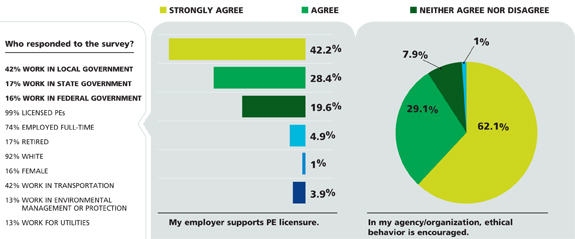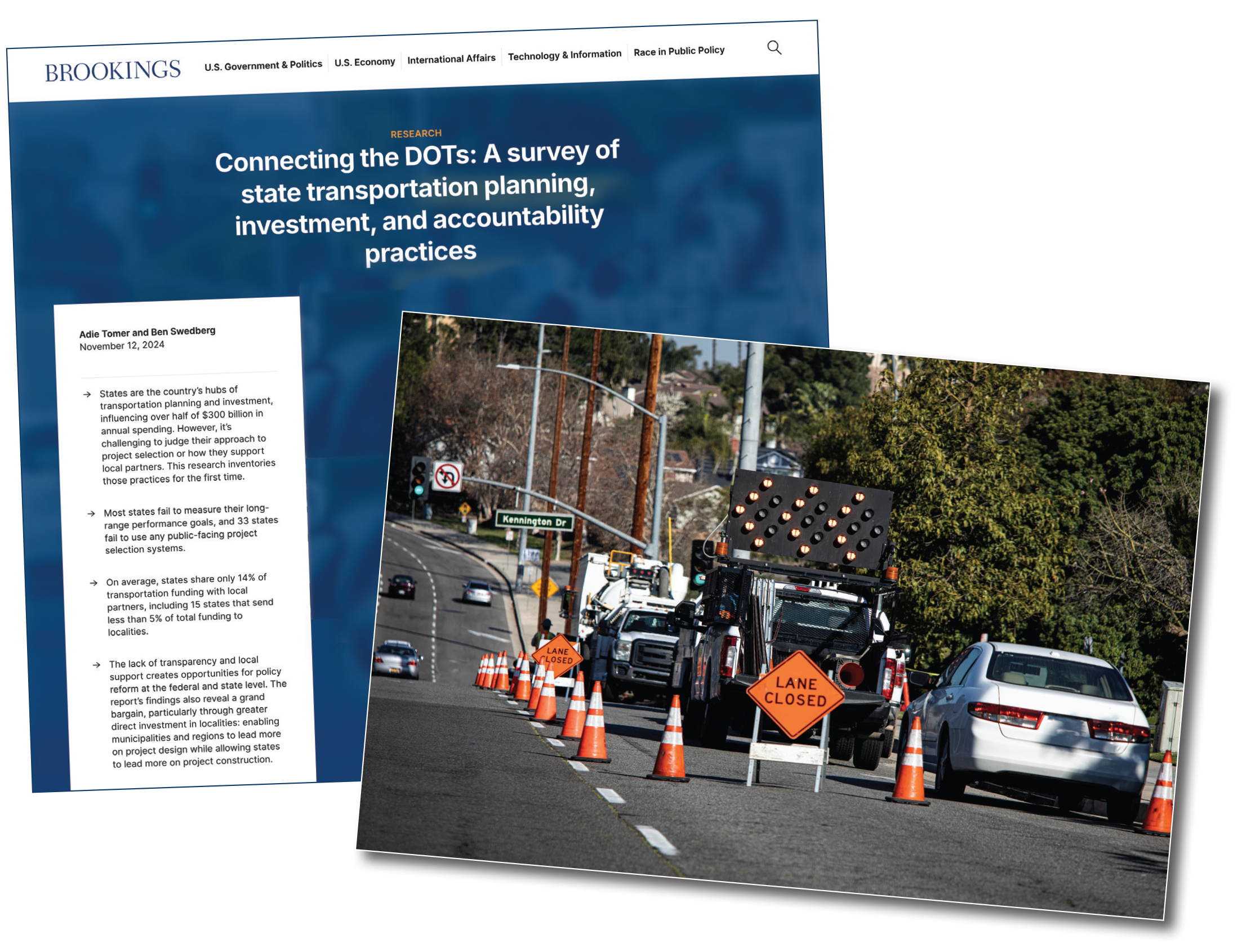April 2014
COMMUNITIES: GOVERNMENT
Survey Reveals Government PEs’ Opinions
Members of NSPE’s Professional Engineers in Government largely believe they have employers who are supportive of licensure and that political support for rebuilding US infrastructure is insufficient. Many see their agencies making sustainable design a priority, but they are divided over whether engineering issues are well understood by public officials and government leaders.
In a survey conducted in January, more than 200 PEG members shared their opinion on these and other current topics, such as ethics, qualifications-based selection, and climate change adaptation. While not scientific, the results provide a snapshot of PEG member views.
After the survey, some respondents elaborated on their answers.
Licensure and Ethics
Seventy-one percent of respondents agreed or strongly agreed that their agency or organization supported PE licensure, while only 6% disagreed or strongly disagreed.
Jon Zirkle, P.E., a civil engineering manager at the Tennessee Department of Transportation, says that his department offers step raises for employees who pass the PE exam and obtain their license. “It’s good motivation to get one,” he explains.
The Mississippi Department of Transportation also provides financial incentives—in the form of a higher salary—to PEs, according to pavement management engineer Marta Charria, P.E. She adds that her agency allows employees to study for the licensing exams at work as long as their other priorities are met.
And David Rackmales, P.E., a structural engineer for the US Army Corps of Engineers’ Middle East District in Virginia, says that the nameplates of everyone in his agency who is licensed list the credential. “It’s something we can be proud of and that the Corps of Engineers district is proud of as well and wants to show people,” he says. Displaying the initials also provides an example to new engineers who are striving to obtain the PE, Rackmales says.
On ethics, survey respondents gave their organizations an even higher grade. Ninety-one percent of respondents agreed or strongly agreed that their agency or organization encouraged ethical behavior. Only 1% disagreed.
Image
Asked whether they thought the image and stature of engineers in government is positive, 68% agreed to some degree and 13% disagreed.
Zirkle says that he and other TDOT engineers have sensed confidence from the public on projects such as roadways, dams, and other types of infrastructure.
But others take a less positive view. For instance, several respondents thought that the image of engineers in the sector had been affected by a negative or declining view of government in general.
And a few noted that not enough people knew what engineers in government (or in general) do. “Perhaps we need a movie where the hero is a government engineer,” says Rackmales.
He also believes that the public sees bureaucracy, delays, and inconvenience instead of progress on complicated projects. “We’ve got a lot of rules and regulations that are in place for good reasons,” he says. “We have to follow the law. That’s ethics.”
A few survey respondents stated that government engineers’ image had been harmed by the practice of filling positions they believe should require a PE with unlicensed professionals or nonengineers.
A very high percentage of participants, 94%, believe that positions of responsibility within government engineering organizations should require the PE license. Thirty-three percent of respondents report to a nonengineer, 7% to an unlicensed engineer, and 60% to a PE.
The Political Perspective
Responses were evenly split on whether engineering issues were well understood by public officials and government leaders in respondents’ areas. A third agreed, a third neither agreed nor disagreed, and a third disagreed.
But the answer regarding political support for rebuilding US infrastructure was much more decisive. Three-quarters of respondents believed that political support was insufficient. Only 12% thought that it was.
“I know that President Obama is pushing it,” says Charria, “but it’s going to be a big chunk of money.”
Zirkle, who answered that he did think support was sufficient, clarifies: “If you ask everyone, ‘Do you want this new bridge, this new road, these roads paved, these bridges well maintained?’ everyone will say yes. But when it comes to funding, [it’s] lacking. The support in dollars is not there.”
While several people noted political forces or the public’s lack of understanding about the importance of infrastructure as obstacles, the majority of those who elaborated on their choice within the survey pointed to funding issues as the major roadblock. A couple believe that the only way infrastructure will get fixed is in the event of a disaster, since it is often out of sight, out of mind.
The majority of respondents (62%) believed that political support for rebuilding infrastructure had stayed the same over the last year. Twenty-four percent thought it had decreased and 14% thought it increased.
All About the Green
Slightly over half of participants said that sustainable design was a priority for their agencies or organizations.
“The leadership here has promoted economic design that is more efficiently maintained over time,” says Zirkle. “If your designs are wearing well and are more easily or efficiently maintained, that’s part of being sustainable.”
But 43% neither agreed nor disagreed that their organization is taking steps to address climate change from an engineering perspective. A couple of comments noted that fiscal constraints have impeded efforts.
Anything sustainable or green is very expensive, Charria stresses. “It’s like moving a big ship, kind of difficult.” She predicts that private industry will take the lead in this area.
Lack of information was another obstacle mentioned. Says Zirkle, “I don’t feel that there’s enough info in the design realm to make large-scale changes in how we do things, based on available climate change data right now.”
Key Issues
PEG members also gave their opinions about issues prominent in the media, such as the automatic federal spending cuts known as sequestration. Twenty-seven percent said they had been negatively affected by sequestration.
The Army Corps was one of those agencies. Rackmales was furloughed for 10 days, along with other engineers. Projects that had been budgeted had to be stopped, he says. The effects are still being felt on some projects, he explains, while on others the district was able to catch up.
Overall, news about the financial position of respondents’ employers was mixed. About 22% said that budgets at their agency or organization have increased in the last year, 44% said they’ve stayed the same, and 34% said they have decreased.
Responses about staffing were similar. Fourteen percent said staffing in their agency or organization has increased in the last year, 50% said it has stayed the same, and 37% said it has decreased.
Not replacing workers who retire is one way agencies and organizations are decreasing staff. Says Charria, “some of those positions start fading out. Other people are taking the load.”
When asked about employee shortages due to retirements, half of respondents agreed that they are experiencing or will experience shortages in the next five years as older workers depart.
“Sometimes I see a bunch of people all leaving at the same time,” says Charria. “There’s a lot of knowledge that walks out the door.”




 Volunteering at NSPE is a great opportunity to grow your professional network and connect with other leaders in the field.
Volunteering at NSPE is a great opportunity to grow your professional network and connect with other leaders in the field. The National Society of Professional Engineers (NSPE) encourages you to explore the resources to cast your vote on election day:
The National Society of Professional Engineers (NSPE) encourages you to explore the resources to cast your vote on election day:




